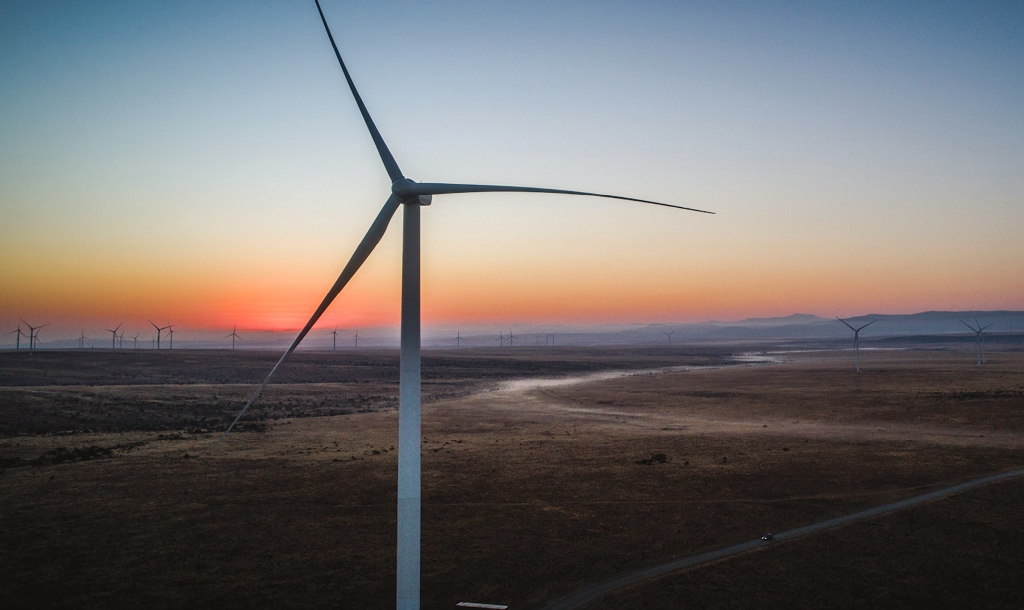The announcement in May 2021 that the 123 MW Golden Valley Wind Energy Facility near Cookhouse south of Cradock in the Sarah Baartman District Municipality had reached commercial operations means that the energy requirements of about 120 000 households will be met.
The announcement by BTE Renewables was also typical of statements being issued by companies operating in the province with increasing regularity. The Eastern Cape really is South Africa’s wind power province.
South Africa’s National Development Plan (NDP) requires 20 000 MW of renewable energy by 2030 and wind power technology, together with solar photovoltaic, are the two primary methods that are being deployed in pursuit of that target.
Just a few kilometres east of Cookhouse there are a further two wind farms, both awarded to Enel Green Power (EGP) in the fourth round of the country’s Renewable Energy Independent Power Producer Procurement Programme (REIPPPP). The Nxuba and Nojoli wind farms will respectively produce 140 MW and 88 MW and represent what might be called Enel’s Eastern Cape mountain area investment. On the coast they have built wind farms at Oyster Bay and Gibson Bay, west of the 138 MW Jeffreys Bay Wind Farm, which is run by Globeleq and was one of the country’s first big wind energy facilities.
The suitability for wind power generation of the Eastern Cape’s coastline and its mountainous regions is illustrated again in the profile of Cennergi, the energy company that was born of diversified resources company Exxaro. Cennergi has the 134 MW Amakhala Emoyeni Wind Farm project near Bedford in the Winterberg mountains and the 95 MW Tsitsikamma Community Wind Energy Facility (TCWF) close to the sea, about 30 km west of Humansdorp.
Ownership
The Golden Valley Wind Energy Facility is owned by BTE Renewables (60%), Thebe Investment Corporation (37.5%) and a local community trust (2.5%). This is a typical ownership structure for renewable energy power projects under the REIPPPP. The REIPPPP has attracted a good deal of praise for its efficiency and effectiveness: in five years about R200-billion was committed in investments in a variety of projects all over South Africa.
South Africa’s two biggest institutional investors, the Industrial Development Corporation (IDC) and the Public Investment Corporation (PIC), have played a big role in helping communities fund participation in community trusts which have taken ownership stakes in power projects.
The REIPPPP was derailed for a period but is now back on track. One of the sad results of the refusal by national utility Eskom to buy renewable power for two years was the closing down and auctioning off of a wind tower manufacturing plant in the Eastern Cape. DCD Wind Towers was a joint venture between the DCD Group and the Industrial Development Corporation (IDC) at Coega.
The REIPPPP was derailed for a period but is now back on track.
The South African Wind Energy Association (SAWEA) has issued a Commitment Statement which noted that the REIPPPP has a “built-in demand for local procurement”, not only offering business opportunities to local companies, but also incentivising the industry to identify and support emerging entrepreneurs.
The rollout of renewable energy has met some resistance in South Africa from constituencies as diverse as coal-truck drivers and advocates of nuclear power. In response, renewable energy advocates cite not just investment figures, but they note how much good work has been done in communities.
Figures released by SAWEA show shareholding for local communities at an estimated net income of R29.2-billion over the lifespan of the projects. Some 14 000 new jobs are expected to be created, mostly in rural areas, and more than R30-billion has already been spent on Black Economic Empowerment (BEE) in the construction phase.
Part of the SAWEA Commitment Statement reads, “Our aim over time is to transform and indigenise leadership at all levels in the South African Renewable Energy sector.”
The average lead time in the projects that have so far been approved in the province is two years, with local content averaging out at about 47%. When the projects are complete, R142.9-billion will have been spent on procurement, R65.7-billion of which will be local.
When the projects are complete, R142.9-billion will have been spent on procurement, R65.7-billion of which will be local.
The Eastern Cape is now home to more than 15 wind farms. More than half the wind farm projects so far approved in the REIPPPP have been allocated to the province. The Kouga area west of Jeffreys Bay and the Cookhouse/Bedford area about 95 km north-west of Makhanda (Grahamstown) represent two wind power hubs, with a collective capacity of 1 185 MW.
POWERX has signed up with AKM Foods to supply power to all the KFC outlets in Nelson Mandela Bay. POWERX trades in renewable energy through licences granted to it by the national energy regulatory authority, NERSA. By aggregating power purchases, the company is able to mitigate risk in a way that an individual purchaser may not be able to. POWERX now supplies over 40 national and local customers in Nelson Mandela Bay and it aims to expand the customer base.


